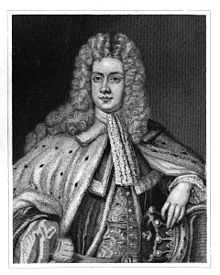Earl of Derwentwater
Earl of Derwentwater (pronounced "Darwentwater") was a title in the Peerage of England. It was created in 1688 for Sir Francis Radclyffe, 3rd Baronet. He was made Baron Tyndale, of Tyndale in the County of Northumberland, and Viscount Radclyffe and Langley at the same time, also in the Peerage of England. He was succeeded by his son, the second Earl. He married Lady Mary Tudor, daughter of Charles II by his mistress Moll Davis. Their eldest son, the third Earl, was a prominent Jacobite. In 1716 he was convicted of high treason, attainted and executed on Tower Hill in London. Despite having been stripped of his titles through the attainder, his only son John, titular 4th Earl of Derwentwater, continued to use them. On John's early death in 1731 they were claimed by his uncle, Charles Radclyffe, titular 5th Earl. He was also a Jacobite but managed to escape to France after the 1715 rebellion, where he was secretary to Charles Edward Stuart ("Bonnie Prince Charlie"). However, he was captured by British forces in 1746, condemned to death and beheaded. Charles married Charlotte Maria, 3rd Countess of Newburgh. Their eldest son James succeeded his mother as 4th Earl of Newburgh and his father as titular 6th Earl of Derwentwater. James's son Anthony succeeded in the titles on his father's death in 1787. However, the male line died out on his death in 1814, when the Radclyffe titles became technically extinct. The title has not been used since. However, he was succeeded in the earldom of Newburgh by an Italian kinsman (see Earl of Newburgh for further history of this title). The Baronetcy, of Derwentwater in the County of Cumberland, was created in the Baronetage of England in 1620 for Francis Radclyffe.[1]
Radclyffe Baronets, of Derwentwater (1620)
- Sir Francis Radclyffe, 1st Baronet (1569–1622)
- Sir Edward Radclyffe, 2nd Baronet (1589–1663)
- Sir Francis Radclyffe, 3rd Baronet (1625–1697) (created Earl of Derwentwater in 1688)
Earls of Derwentwater (1688)
- Francis Radclyffe, 1st Earl of Derwentwater (1625–1697)
- Edward Radclyffe, 2nd Earl of Derwentwater (1655–1705)
- James Radclyffe, 3rd Earl of Derwentwater (1689–1716) (forfeit 1716)
Titular Earls of Derwentwater
- John Radclyffe, titular 4th Earl of Derwentwater (1713–1731)
- Charles Radclyffe, titular 5th Earl of Derwentwater (1693–1746)
- James Bartholomew Radclyffe, 4th Earl of Newburgh and titular 6th Earl of Derwentwater (1725–1787)
- Anthony James Radclyffe, 5th Earl of Newburgh and titular 7th Earl of Derwentwater (1757–1814)
Estates after the attainder
The family estates were not forfeited on the attainder of the 3rd Earl, because his son's right to them under his marriage settlement was established before the Court of Delegates on appeal from the Forfeit Estates Commission, but the forfeiture took effect on his death in 1731. The estates were granted to Greenwich Hospital in 1735. However, after the execution of Charles Ratcliffe in 1746, his son James, Lord Kinnard, claimed them. This claim was compromised by £30,000 being paid to him and his siblings. On his death in 1746, his son obtained an annuity of £2500 for himself and his widow. The estates remained in the hands of the Hospital Commissioners until 1865, when they were transferred by the Greenwich Hospital Act 1865 to the Admiralty Board, who sold them.[2]
See also
References
- ↑ George Edward Cokayne Complete Baronetage Volume 1 1900
- ↑ H. H. E. Craster, A History of Northumberland X, Corbridge, 295-303.
External links
- The Radcliffes of Dilston Hall
